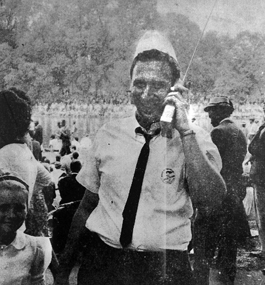“I Have a Dream Today”: Remembering the March

Courtesy Jules Bernstein
Bernstein at the 1963 march
by Jules Bernstein ’57
Fifty years ago — on Aug. 28, 1963 — I had a lot on my mind.
Along with other organizers of the March on Washington for Jobs and Freedom, I had been preparing for weeks for the arrival — by bus, car, plane and foot — of tens of thousands of Americans in the nation’s capital, coming to protest terrible injustices created by racism in employment, voting, public accommodations, housing and education.
On the day of the march, I was responsible for responding to emergencies and preventing disruptions in my assigned section of the National Mall. I had a huge walkie-talkie for contacting march leaders, the police and others as needed.
At the time, I was a lawyer for the 1.5 million-member International Brotherhood of Teamsters, then under the leadership of Jimmy Hoffa. However, my involvement in the civil rights movement went back to my Brandeis days. In 1956, I joined the students and faculty who packed Ford Hall to hear the Rev. Dr. Martin Luther King Jr. speak during the Montgomery bus boycott, which King was then leading. In my youthful innocence, I thought, Where will all this preaching get him? How wrong I was.
During law school at the University of Chicago, I joined the Young People’s Socialist League. We helped support the sit-ins that broke out across the South in the spring of 1960. Later, after I became a union lawyer, I helped integrate a Jim Crow swimming pool in suburban Maryland; worked with Stokely Carmichael to integrate a shirt factory in Albany, Ga.; and, with the Teamsters union’s support, organized a fundraiser for the Student Nonviolent Coordinating Committee (SNCC), at which a very young Bill Cosby kept us all laughing.
So, for me, the March on Washington was the culmination of many years of civil rights activity. The idea for such a protest came from A. Philip Randolph, the venerable leader of the 10,000-member sleeping-car porters union. He believed the event would strengthen the momentum of the sit-ins, the Freedom Rides and the other civil rights struggles under way. The NAACP, the Congress of Racial Equality (CORE), the National Urban League, the United Auto Workers and SNCC all signed on. Civil rights leader Bayard Rustin, whom I knew from my Chicago days, was appointed march coordinator.
As the day of the march approached, fears of violence mounted. Editorials in The New York Times and The Washington Post urged organizers to call off the march to avoid altercations that might hurt the civil rights cause. President John F. Kennedy made a similar request. But Rustin and the other march leaders were undeterred.
On Aug. 28, I was at my station on the mall by 5:30 a.m. As the dawn rose, all was quiet. Soon, buses began dropping people off around the Washington Monument, where Peter, Paul and Mary, Bob Dylan, Odetta and dozens of other performers sang for hours.
Around midday, the huge throng of people from all over the country marched arm in arm down the mall and Constitution Avenue, and assembled in front of the Lincoln Memorial to hear the event’s speakers. People carried banners and signs representing churches, synagogues, NAACP chapters and unions. The great gospel singer Mahalia Jackson sang “I’ve Been ’Buked and I’ve Been Scorned.” King delivered his famous “I Have a Dream” speech.
After the applause for King had faded, Rustin read the march’s demands. Listening to him, I thought it was he who was dreaming, even more so than King. Once again, I was wrong. Within two years, Congress had enacted anti-discrimination laws in the areas of voting rights, employment, housing and public accommodations.
When the inspiring day ended and the estimated 250,000 marchers had left, many of my fellow activists gathered for a celebration at a rundown Washington hotel. (Joan Baez showed up and danced.) In subsequent days, we held a conference at which Rustin, Randolph, Norman Thomas, James Farmer and Eleanor Holmes Norton discussed what the march had accomplished and what still needed to be done.
This year on Aug. 28, anniversary celebrations in Washington, D.C., and across the U.S. will recall the march and its achievements. But many of us believe the march’s full promise remains unfulfilled. The dream of equality has been undermined by the increasing economic divide in the U.S. As Louis Brandeis warned long ago, “We may have democracy, or we may have wealth concentrated in the hands of a few, but we can’t have both.”
A central demand of the March on Washington was the reduction of unemployment. In 1963, the unemployment rate was 5.4 percent. Today, it is 7.5 percent. The black unemployment rate was about 11 percent in 1963, compared to 14 percent today. Considering the growth of the black population over the past 50 years, this means the number of unemployed black workers has almost doubled.
My march-inspired mantra in 2013 is simple: “We may have come a long way, but we’ve got a long way to go.”
Jules Bernstein is a labor lawyer in Washington, D.C., founded the Louis D. Brandeis Legacy Fund for Social Justice at Brandeis, and is a member of the advisory board for Brandeis’ International Center for Ethics, Justice and Public Life.
